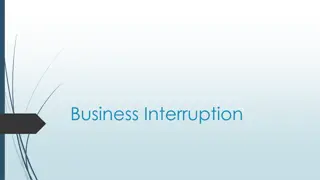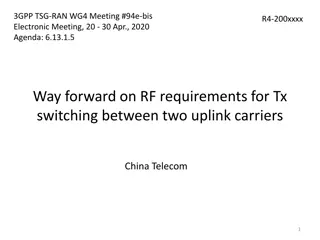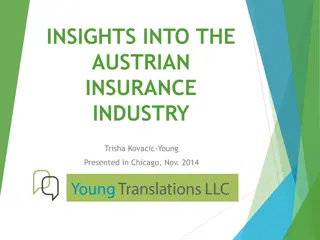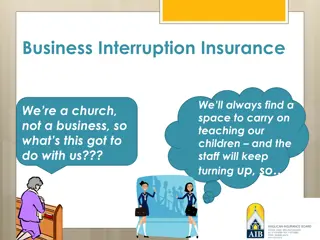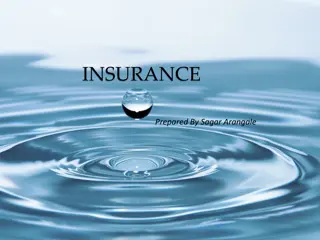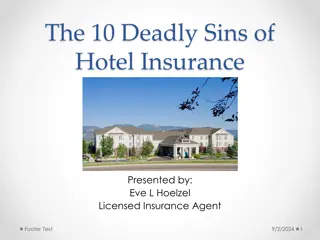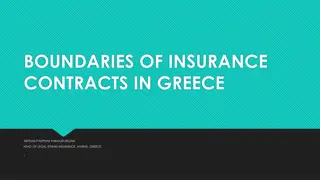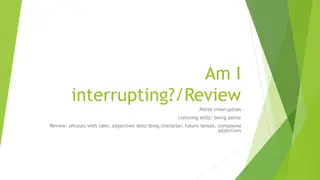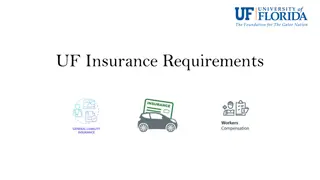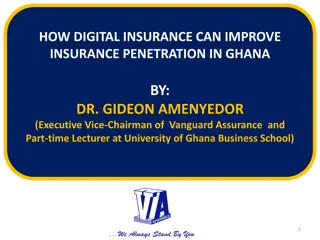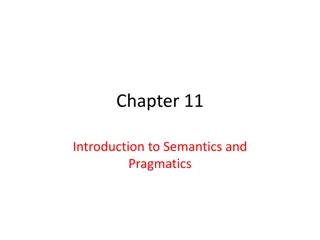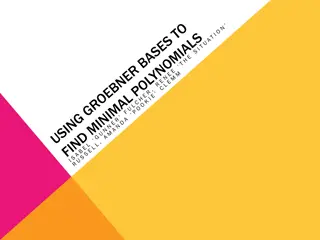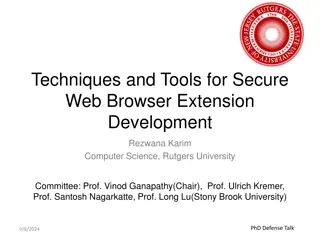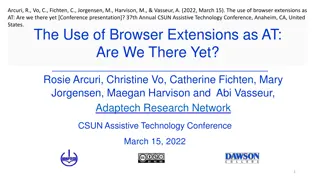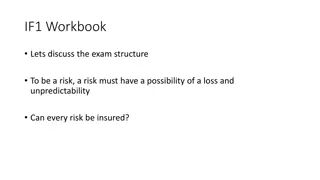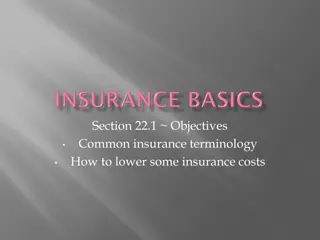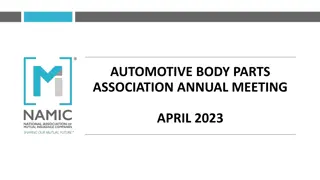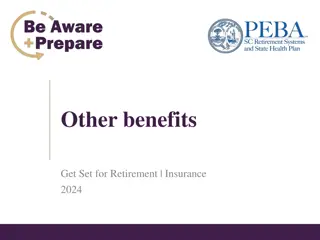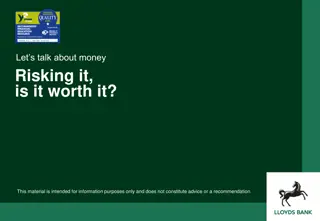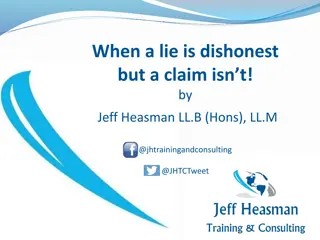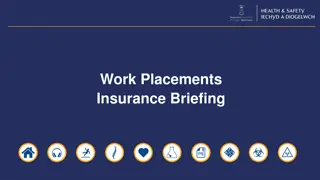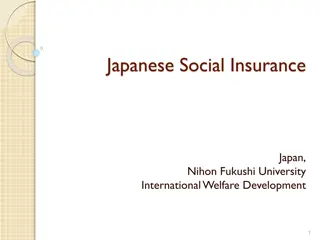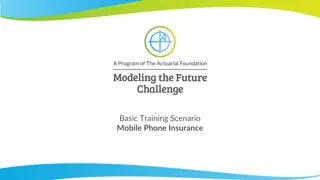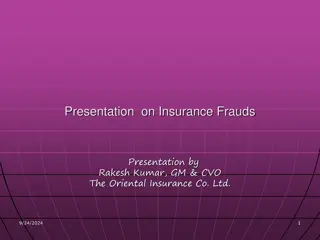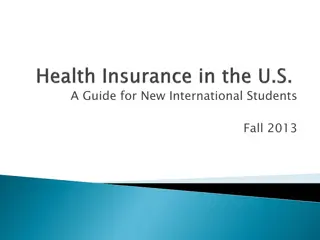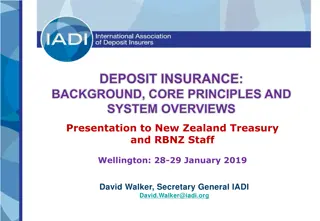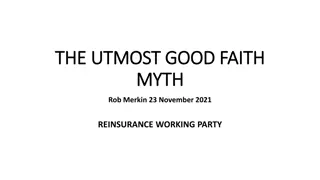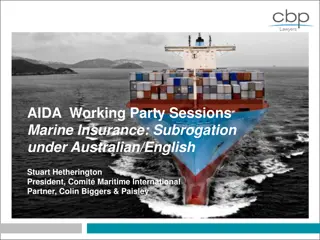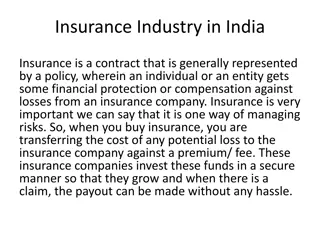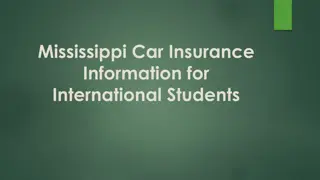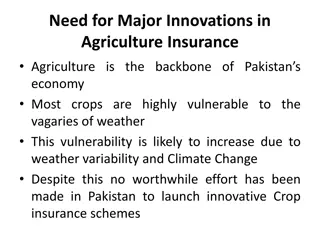Understanding Business Interruption Insurance and Extensions
Alan Chandler, a Chartered Insurer with extensive training experience, shares valuable insights on Business Interruption Insurance (BI). Learn about gross profit vs. insured profit, indemnity periods, sum insured projections, and BI cover for service firms. Explore various BI extensions, such as customer and suppliers extensions, denial of access, loss of attraction, utilities, and terminal ends. Discover the purpose of BI insurance and advanced topics like overseas extensions and advanced loss of profits. Enhance your knowledge to guide clients effectively in setting up appropriate BI coverage.
Download Presentation

Please find below an Image/Link to download the presentation.
The content on the website is provided AS IS for your information and personal use only. It may not be sold, licensed, or shared on other websites without obtaining consent from the author. Download presentation by click this link. If you encounter any issues during the download, it is possible that the publisher has removed the file from their server.
E N D
Presentation Transcript
Alan Chandler Chartered Insurer, trains across Europe alanchandler@uwclub.net BUSINESS INTERRUPTION INSURANCE Living the dream! . 1
Alan Chandler, Chartered Insurer I have trained more than 2,000 individuals to become ACII qualified I have trained over 50% of the individuals in the last 8 years that have gone onto achieve the highest ACII pass in the whole of the UK. I train to a pass rate of more than 96% in all CII qualification levels. Certificate , Diploma and Advanced Diploma. I deliver the Allianz scholarship and academy programmes in both the UK and Ireland and I have been a Cii examiner. I have trained students who have won national prizes in almost all ACII subjects including Insurance Law (MO5), Liability (M96), Commercial Property and BI (M93), Personal Lines Insurance (P86), Business and Finance (M92), Underwriting Practice (M80), Advanced Underwriting (960), Claims Practice (M85), Advanced Claims (820), Marketing (945), Advanced Broking (930) and Advanced Risk Management (992). Contact me on Linkedin or alanchandler@uwclub.net
Learning Objectives Delegates will Be able to explain to your clients the difference between accounting gross profit and insurance gross profit. Know how to guide your clients correctly so that they set an appropriate indemnity period. How to project a correct sum insured through an indemnity period. How to best set up BI cover for service firms with no stock. Be able to guide your clients on setting an appropriate sum insured for increased cost of working only cover. Be able to explain the difference between increased cost of working and additional increased cost of working. Understand declaration linked cover and trending sums insured Understand the wordings of a Bi claim . 3
Learning Objectives Delegates will be able to understand Customer and suppliers BI extensions and why insurers should try and do more on the overseas extension side Denial of access extensions Disease, food poisoning, murder etc extension Loss of attraction extension and how this differs from denial of access Utilities and terminal ends and how these differ Advanced loss of profits and why this is so under sold Many other of the BI extensions offered in the market place and when they are appropriate for a risk . 4
Bi Cover costs and income What is the purpose of Business Interruption Insurance? . 5
Gross profit / Insured profit To start with we are going to look at how we protect firms who have stock. Traditionally this has been called Gross Profit cover but sometimes it is now called Insured Profit. We are going to look at the Gross profit (Insured profit) formula and in order to understand it we need to look at the costs and the income that would and would not be covered under a BI policy. . 6
The difference between costs Fixed or Variable Some are fixed costs and remain payable during the indemnity period whether the business trades or not These are known as standing charges and need to be insured Some of the costs are variable and do not need to be covered by the BI policy These are variable charges and do not need to be insured. These are often called Uninsured Working Expenses or Specified Working Expenses Which is your favourite Bi wording? 7
Costs We need to identify the insured working expenses which are PPT, Bad debts net of any discounts allowed. . 8
Income Only profit directly related to the trading portion of the business is covered. Let s explore 9
INCOME Remember income can also mean turnover, revenue or sales . 10
Net Profit What is this and does it get covered by a BI policy? . 11
The Additions Basis of BI Historically net profit was added to standing charges to make a sum insured to form a Gross Profit sum insured why did this need to be changed? 12
The Difference basis of Gross Profit Gross Profit (Insured Profit) sum insured is defined as :- The combined sum of the turnover, closing stock and work in progress less the combined sum of the opening stock and work in progress and uninsured working expenses Uninsured working expenses are specified in the policy usually as Purchases, Packing , Transport costs, bad debts and discounts allowed. 13
Case Study Manufacturing Mike Mike manufacturers metal cases, his figures from last years accounts were: Turnover 2,420,000 Expenses are: Wages for staff not directly involved in manufacturing 300,000 Depreciation on machinery 20,000 Purchases 730,000 Transportation of goods 100,000 Accountants fees 20,000 Utility bills not used in manufacturing 60,000 Electric used in the manufacturing process 100,000 Wages for staff who are employed in the manufacturing process 500,000 Rent of premises 150,000 Packaging 70,000 Work in progress 01/01/18 100,000. Work in progress 01/01/17 200,000 Opening stock 100,000. Closing stock 180,000 14
Manufacturing Mikes Insurance Gross Profit Lets compare this to the accountants Gross Profit and see why brokers get sued so often for bad advice on Bi. 15
GROSS FEES/REVENUE/INCOME So far we have looked at Gross profit otherwise known as Insured profit. What is the position for firms that do not have stock? We arrange cover on a Gross fees, Gross revenue or gross income basis is there any difference? . 16
The Indemnity Period A business can take much longer than they think to recover after a loss so the policy contains an indemnity period. Why is it so important to talk to clients around this? 17
Factors affecting an Indemnity Period Rebuilding Premises Replacing machinery/Contents 18
Factors affecting an Indemnity Period Specialist Staff Replacing Stock/ other seasonal factors Rebuilding the Customer Base . 19
Increased Cost of Working (ICW) It is in an insurer s interest to spend some additional money to allow a business to get to work speedily to offset the loss of turnover following an insured event. A BI policy on gross profit or gross income will automatically include Increased Cost of Working providing it is economic, what do we mean by this phrase? Let s go through some of the main examples of ICW 20
Additional Increased cost of working If we introduce the extra word of Additional we change the legal position what extra cover does this provide? Do Underwriters need to charge for this? What are the main risks that may require additional increased cost of working? 21
Increased Cost of working only For firms that provide a service there are two main options 1. Gross fees (or revenue) or 2. Increased cost of working only List some of the main things an insured would get paid if they took the more expensive gross fees over the cheaper ICW option 22
Increased cost of working If an insured took out an ICW only policy how do they go about setting the correct sum insured? Would it be appropriate for an insured with a lot of stock to have ICW only? 23
Projecting a correct sum insured If you remember Manufacturing Mike The insured has an indemnity period of 24 months The insured has stated that their growth including an allowance for inflation is projected to run at 5% per annum for the foreseeable future. How do we calculate a correct sum insured? . 24
Declaration Linked What does this do, why was it introduced and why should clients always be put in this basis wherever possible? 33 .
Business Interruption Extensions Firstly the most common 1. 2. 3. 4. 5. 6. Specified Customers Unspecified Customers Specified Suppliers Unspecified Suppliers Prevention of access (damage) Prevention of access non damage (Action by police or other authority) Public Utilities Terminal ends (accidental failure of utilities) Specified disease, food poisoning, vermin, pests, defective sanitation, murder or suicide 10. Loss of attraction 7. 8. 9. . 26
BI Extensions Specified Suppliers Unspecified suppliers . 27
BI Extensions Specified Customers Unspecified Customers . 28
BI Extensions Prevention of access damage . 29
Bi Extensions Prevention of access non damage (action by police or other authority) . 30
BI Extensions Public Utilities Damage at the suppliers premises ONLY . 31
BI Extensions Terminal ends (accidental failure of utilities) or full failure contingencies How does this differ from utilities extension? . 32
BI Extensions Specified disease, food poisoning, vermin, pests, defective sanitation, murder or suicide . 33
BI Extensions Loss of attraction Loss must be at least 12 hours Ideally the attraction should be specified within the extension, sometimes insurers put a one mile radius in the wording of this extension instead. The radius wording could be regarded as poor policy wording construction in some circumstances, as it vagueness does not help at point of claim, and could fail to actually cover the intended risk (not very TCF!) . 34
BI Extensions Property Stored in third party premises (not mentioned on the schedule and not occupied by the insured) . 35
Bi Extensions Exhibition Sites If possible the insured should have a record of previous sales at the exhibition otherwise loss substantiation becomes difficult . 36
BI Extensions Contract Sites This is aimed not at the owner of the site, but at contractors who commit lots of resource to a building project that gets postponed because of the operation of an insured peril. . 37
Advanced Loss of profits How do we calculate a correct sum insured and indemnity period given the insured has not yet started trading? When should the insurance policy start? When does a claim start? . 38
Advanced loss of profits REMEMBER The three main differences for advanced loss of profit . 39
Stages of a BI claim 1. Trends and variations in turnover or rate of Gross Profit 2. Calculate reduction in turnover (trended where appropriate) Formula: Standard turnover turnover during indemnity period. 3. Calculate rate of gross profit (insured profit) . Formula is Gross profit for last financial year x 100 Turnover for the last financial year Note the GP above is not the sum insured but the actual GP based on the insured s accounts 4. Apply rate of GP to reduction in turnover to get loss of gross profit 5. Add amount of any increased cost of working (check economic limit). If ICW is above economic limit then AICOW can pick this up if insured. 6. Deduct any savings made 7. Accountant s charges if INSURER (not client) has accountant charges these get added to claim 8. Check for average unless declaration linked (in which case do not pay more than 133.333% of the sum insured). . 40
Learning Objectives Delegates will Be able to explain to your clients the difference between accounting gross profit and insurance gross profit. Know how to guide your clients correctly so that they set an appropriate indemnity period. How to project a correct sum insured through an indemnity period. How to best set up BI cover for service firms with no stock. Be able to guide your clients on setting an appropriate sum insured for increased cost of working only cover. Be able to explain the difference between increased cost of working and additional increased cost of working. Understand declaration linked cover and trending sums insured Understand the wordings of a Bi claim . 41
Learning Objectives Delegates will be able to understand Customer and suppliers BI extensions and why insurers should try and do more on the overseas extension side Denial of access extensions Disease, food poisoning, murder etc extension Loss of attraction extension and how this differs from denial of access Utilities and terminal ends and how these differ Advanced loss of profits and why this is so under sold Many other of the BI extensions offered in the market place and when they are appropriate for a risk . 42


